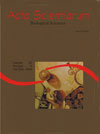<b>Absconding and migratory behaviors of feral Africanized honey bee (<em>Apis mellifera</em> L.) colonies in NE Brazil</b> - DOI: 10.4025/actascibiolsci.v29i4.882
Abstract
We investigated the annual movements of feral Africanized honey bee (Apis melliferaL.) colonies in the state of Ceará, Brazil, aiming to understand seasonal variations in their population. Arrival and absconding of Africanized honey bee (AHB) colonies in the semiarid municipality of Canindé and the coastal humid city of Fortaleza (120 km apart) were recorded weekly from January 1999 to December 2001, and the data compared to rainfall records in both areas. Results showed that AHB colonies only nest in the semiarid during the rainy season and abscond during the dry season, the opposite from observations taken in Fortaleza. Only 5% of colonies remained in the semiarid area for the entire year due to ant (Camponotus sp.) attacks and shortage of nectar and water during the dry season, with most colonies migrating to coastal areas where the weather is milder and many plant species bloom at that time of year. Excessive rainfall probably pushes AHB colonies back to the semiarid during the rainy season. We concluded that absconding and migration are strategies that allow AHB colonies to survive in the semiarid NE of Brazil, contrary to European honeybees, which have never succeeded in establishing wild colonies in the region.Downloads
Download data is not yet available.
Published
2008-02-21
How to Cite
Freitas, B. M., Souza, R. M., & Bomfim, I. G. A. (2008). <b>Absconding and migratory behaviors of feral Africanized honey bee (<em>Apis mellifera</em> L.) colonies in NE Brazil</b> - DOI: 10.4025/actascibiolsci.v29i4.882. Acta Scientiarum. Biological Sciences, 29(4), 381-385. https://doi.org/10.4025/actascibiolsci.v29i4.882
Issue
Section
Ecology and Limnology
DECLARATION OF ORIGINALITY AND COPYRIGHTS
I Declare that current article is original and has not been submitted for publication, in part or in whole, to any other national or international journal.
The copyrights belong exclusively to the authors. Published content is licensed under Creative Commons Attribution 4.0 (CC BY 4.0) guidelines, which allows sharing (copy and distribution of the material in any medium or format) and adaptation (remix, transform, and build upon the material) for any purpose, even commercially, under the terms of attribution.
Read this link for further information on how to use CC BY 4.0 properly.
0.6
2019CiteScore
31st percentile
Powered by 

0.6
2019CiteScore
31st percentile
Powered by 











1.png)




3.png)













